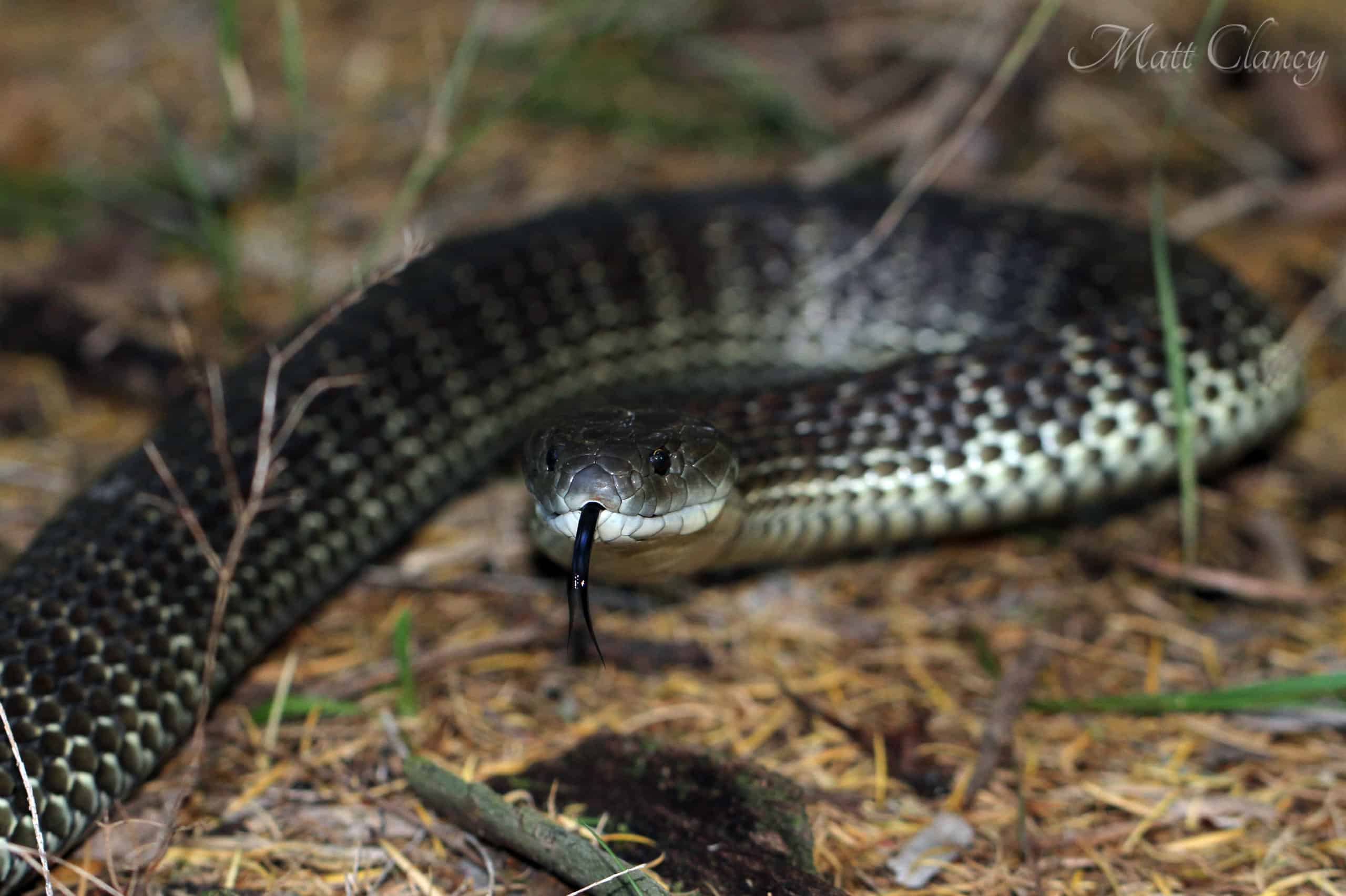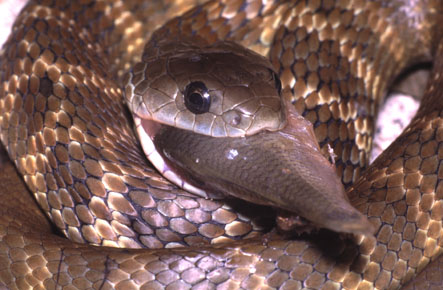
Eastern Tiger Snake
Eastern Tiger Snake
The Eastern Tiger Snake (Notechis scutatus) is a venomous snake species native to southeastern Australia, including the states of Victoria, New South Wales, and Tasmania. It is a member of the Elapidae family, which includes other venomous snakes such as cobras and coral snakes.
The Eastern Tiger Snake can grow up to 1.5 meters (4.9 feet) in length, a
nd its coloration can vary from dark brown to black, with yellow, cream or white bands or spots on its body. It is a highly venomous snake, with potent neurotoxic venom that can cause paralysis and death if not treated promptly.
Despite its venomous nature, the Eastern Tiger Snake is shy and generally avoids human contact. It is most active during the day and feeds on a variety of prey, including small mammals, birds, and lizards. The species is also known for its distinctive defensive behavior, which involves flattening its body and hissing loudly when threatened.
In some parts of Australia, the Eastern Tiger Snake is protected by law and considered an important component of the ecosystem. However, it can also pose a threat to livestock and pets, and encounters with humans can be dangerous. As with all venomous snakes, it is important to exercise caution and seek immediate medical attention in the event of a bite.
Here is the classification of the Eastern Tiger Snake:
- Kingdom: Animalia (animals)
- Phylum: Chordata (vertebrates)
- Class: Reptilia (reptiles)
- Order: Squamata (scaled reptiles)
- Suborder: Serpentes (snakes)
- Family: Elapidae (cobras, coral snakes, and their relatives)
- Genus: Notechis
- Species: Notechis scutatus (Eastern Tiger Snake)
The full scientific name for the Eastern Tiger Snake is Notechis scutatus.

Characteristics
Here are some of the key characteristics of the Eastern Tiger Snake:
-
Size: The Eastern Tiger Snake can grow up to 1.5 meters (4.9 feet) in length, although most individuals are smaller than this.
-
Coloration: The species has a distinctive pattern of dark brown or black coloration, with yellow, cream or white bands or spots on its body.
-
Venom: The Eastern Tiger Snake is highly venomous, with potent neurotoxic venom that can cause paralysis and death if not treated promptly.
-
Reproduction: Eastern Tiger Snakes are oviparous, meaning they lay eggs. The females lay clutches of up to 20 eggs, which hatch after around 2-3 months.

Behavior
Eastern Tiger Snakes are diurnal, meaning they are active during the day, and they spend much of their time hunting for prey, such as small mammals, birds, and lizards. They are also known to scavenge for food, especially near water bodies.
During the breeding season, which typically occurs in spring and early summer, male Eastern Tiger Snakes engage in combat with one another to establish dominance and mating rights. Females lay their eggs in moist environments, such as under logs or rocks or in other concealed areas, and they may guard their eggs until they hatch.
Eastern Tiger Snakes are solitary creatures that typically only interact with other individuals during the breeding season or when competing for resources such as food or shelter. Despite their venomous nature, they play an important role in maintaining the balance of their ecosystems by controlling populations of small mammals and other prey species.
Diet Eastern Tiger Snake
The Eastern Tiger Snake is a carnivorous species that feeds on a variety of prey, including small mammals, birds, lizards, and other snakes. They are opportunistic feeders that hunt actively during the day, using their keen sense of smell to detect potential prey.
Small mammals such as rodents and rabbits are an important part of the Eastern Tiger Snake's diet, but they also consume a variety of other animals, including birds, frogs, and even fish. They have also been known to scavenge for food near water sources.
The Eastern Tiger Snake is an ambush predator that relies on stealth and surprise to catch its prey. They are able to strike very quickly, injecting venom into their prey that immobilizes them and aids in digestion. After capturing their prey, Eastern Tiger Snakes will swallow it whole, using their strong muscles and flexible jaws to consume animals that are often much larger than their own heads.
The Eastern Tiger Snake is an important predator that plays a vital role in maintaining the balance of ecosystems in southeastern Australia.

Habitat Eastern Tiger Snake
The Eastern Tiger Snake is native to southeastern Australia, including the states of Victoria, New South Wales, and Tasmania. Within this region, the species is found in a variety of habitats, including woodlands, heathlands, wetlands, and coastal areas.
Eastern Tiger Snakes are semi-aquatic, meaning they are well-adapted to both terrestrial and aquatic environments. They are often found near water sources such as creeks, rivers, and wetlands, where they hunt for prey and seek refuge from predators.
The species prefers habitats with moderate vegetation cover, such as grasslands or heathlands, where they can hide and ambush prey. They are also known to inhabit agricultural areas and suburban landscapes, where they may take advantage of human-altered environments to find food and shelter.
The Eastern Tiger Snake is a highly adaptable species that is able to survive in a variety of habitats, as long as there is suitable prey and adequate shelter available. However, habitat loss and degradation due to human activities can pose a threat to their populations, as can persecution by humans who view them as a danger to livestock or pets.
How Venomous is the Eastern Tiger Snake ?
The Eastern Tiger Snake is highly venomous, with potent neurotoxic venom that can cause paralysis and death if not treated promptly. Its venom is considered to be one of the most toxic of any snake in the world, and it has been responsible for a number of human fatalities in Australia.
The venom of the Eastern Tiger Snake contains a complex mix of toxins that act on the nervous system, causing paralysis and respiratory failure. The severity of the symptoms depends on the amount of venom injected, the location of the bite, and the health and size of the victim. In some cases, a bite from an Eastern Tiger Snake can be fatal within hours if left untreated.
Despite their potent venom, Eastern Tiger Snakes are generally not aggressive towards humans and will usually only bite in self-defense when threatened or cornered. If you encounter an Eastern Tiger Snake in the wild, it is important to give the animal plenty of space and avoid disturbing it. If you are bitten by an Eastern Tiger Snake, seek immediate medical attention to receive anti-venom treatment, which can be highly effective in preventing serious or fatal outcomes.
Population and Conservation Status
The Eastern Tiger Snake is listed as a species of "Least Concern" on the International Union for Conservation of Nature (IUCN) Red List. This means that the species is considered to be abundant and widespread throughout its range, with no significant threats to its survival.
However, the Eastern Tiger Snake is still susceptible to habitat loss and degradation due to human activities, such as land development and agricultural expansion. The species is also sometimes targeted by humans who view it as a threat to livestock or pets, which can lead to intentional persecution and killing of individuals.
In some parts of its range, the Eastern Tiger Snake is protected by law, which helps to reduce the impact of human activities on the species and its habitat. Conservation efforts are also being undertaken to raise awareness about the importance of preserving snake habitats and reducing the negative impacts of human activities on snake populations.
While the Eastern Tiger Snake is not currently facing significant threats to its survival, continued monitoring and conservation efforts will be important to ensure that the species remains abundant and healthy in the future.
Can a human survive a Eastern Tiger Snake ?
While a bite from an Eastern Tiger Snake can be very dangerous, it is possible for humans to survive if they receive prompt medical attention and anti-venom treatment. The key to survival is early recognition and treatment of the bite.
Symptoms of an Eastern Tiger Snake bite can include pain and swelling at the site of the bite, nausea, vomiting, headache, dizziness, paralysis, and respiratory failure. If you are bitten by an Eastern Tiger Snake, it is important to seek immediate medical attention and call for emergency medical services, as the venom can act quickly and lead to life-threatening complications.
Anti-venom treatment is highly effective in neutralizing the venom of the Eastern Tiger Snake and can prevent serious or fatal outcomes. However, it is important to receive this treatment as soon as possible after the bite, as delay can increase the risk of complications and reduce the effectiveness of the treatment.
While a bite from an Eastern Tiger Snake can be very dangerous, prompt medical attention and treatment can increase the chances of survival and recovery.
Are Eastern Tiger Snake Aggressive?
Eastern Tiger Snakes (Notechis scutatus) are venomous snakes native to southern Australia. While they possess potent venom, their behavior toward humans is generally not aggressive. Like most snakes, they prefer to avoid confrontation and will typically retreat when they perceive a threat.
However, if Eastern Tiger Snakes feel cornered, threatened, or provoked, they may display defensive behaviors, including hissing, flattening their bodies, and striking if they feel they have no other option. These defensive displays are meant to deter potential threats and protect themselves rather than to actively seek out aggression.
It's important to remember that any wild animal, including snakes, should be treated with caution and respect. If you encounter an Eastern Tiger Snake or any snake in the wild, it's best to give them space and avoid any actions that may provoke them.
What happens if you’re bitten by a Eastern Tiger Snake?
Being bitten by an Eastern Tiger Snake (Notechis scutatus) can be a serious medical emergency. Their venom is highly toxic and contains a combination of neurotoxins, coagulants, and myotoxins, which can have various effects on the human body.
After a bite from an Eastern Tiger Snake, symptoms may vary depending on factors such as the amount of venom injected, the location of the bite, and the individual's reaction. Common symptoms may include:
1. Localized pain and swelling around the bite area.
2. Systemic symptoms, such as headache, nausea, vomiting, and abdominal pain.
3. Difficulty breathing and respiratory distress.
4. Neurological symptoms, such as weakness, dizziness, and paralysis.
5. Bleeding and clotting abnormalities due to coagulants in the venom.
6. Kidney damage and other organ dysfunction due to myotoxins.
It's crucial to seek immediate medical attention if you are bitten by an Eastern Tiger Snake or any venomous snake. Call emergency services or go to the nearest hospital as soon as possible. Do not attempt to treat the bite on your own. Apply pressure to the bite area if possible and try to immobilize the affected limb, but do not use tourniquets or apply ice.
Antivenom is the primary treatment for snakebite envenomation. Medical professionals will assess the severity of the bite and administer appropriate antivenom and supportive care to manage the symptoms and minimize complications. Prompt medical intervention significantly improves the chances of a positive outcome.
Here are some fun facts about the Eastern Tiger Snake?
1. Appearance: Eastern Tiger Snakes have a striking and unique appearance. They have a robust body with variable coloration ranging from pale yellow to dark brown or black. Their patterns consist of dark bands or stripes along their body, giving them a tiger-like appearance, hence their name.
2. Habitat: These snakes are primarily found in the southern regions of Australia, including coastal areas, wetlands, grasslands, and woodlands. They are known to inhabit both terrestrial and aquatic environments, often being found near water sources.
3 Venom: The venom of the Eastern Tiger Snake is highly potent and considered to be one of the most toxic among Australian snakes. It contains a mix of neurotoxins, myotoxins, and coagulants. Despite their venomous nature, they generally display non-aggressive behavior towards humans.
4. Diet: Eastern Tiger Snakes are carnivorous and primarily feed on small mammals, such as rodents, as well as birds and reptiles. They are skilled hunters and use their venom to incapacitate their prey before consuming it.
5. Adaptations: These snakes have adaptations that allow them to thrive in their habitats. They are excellent swimmers and can traverse both freshwater and saltwater environments. They also have the ability to flatten their bodies, enabling them to squeeze into narrow crevices or burrows.
6. Reproduction: Eastern Tiger Snakes are viviparous, meaning they give birth to live young instead of laying eggs. Females typically give birth to a litter of 10 to 40 offspring. The newborn snakes are independent and capable of fending for themselves from birth.
7. Conservation Status: Eastern Tiger Snakes are not currently considered endangered. However, habitat loss, pollution, and human persecution pose threats to their populations. They are protected under Australian law, and efforts are made to conserve their habitats.
Remember, while these facts may be interesting, it's important to always exercise caution and respect when encountering wildlife, including Eastern Tiger Snakes.
Blog Upload on - May 11, 2023
Views - 1369

posted By -
Animals Super Store
Related Posts
-
 The role of goats in sustainable agriculture and land management
The role of goats in sustainable agriculture and land management
March 24, 2023 -
Fish Farming Business
Oct. 27, 2022 -
 DELHI BIRD & ANIMAL HELPLINE
DELHI BIRD & ANIMAL HELPLINE
Aug. 27, 2022 -
How To Train A Dog
Oct. 27, 2022 -
Animal Behavior, Thoughts On Choosing A Breed To Raise
July 5, 2023 -
Use Of Goat Milk
Nov. 1, 2022 -
Top 10 Smartest Dog Breeds
March 15, 2023 -
 Types Of Fish Breed Names A to Z
Types Of Fish Breed Names A to Z
Nov. 25, 2022


"I resonate with your passion for history and its lessons. Your connection between past crises and today's challenges is insightful. Your call to action for sustainable farming practices is crucial. As we navigate feeding a growing population, Farming Plan offers valuable insights on climate-smart agriculture. Let's join the fight to shape a better future!"